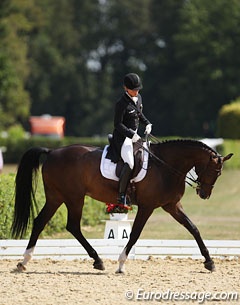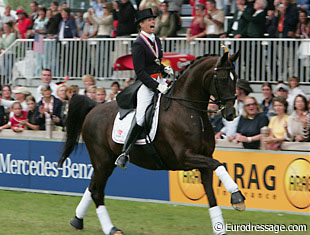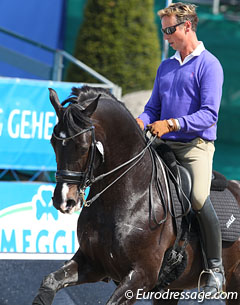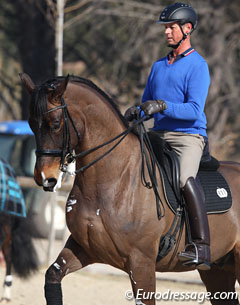
The dressage world is filled with debate as to whether classical dressage and competitive dressage can truly be united. Everyone has a different form of religion and I don't mind what or who or why anyone believes in anything, as long as they don't condemn or force their belief onto someone else.
Training horses is no different and if the rider is ultimately doing their very best to uphold the health, safety and happiness of their horse, than I do not mind if they work their horses up, down, sideways, no bit, bridleless, bareback, or backwards if they so choose.
Obviously there are instances where people lose track and need to be reminded that their horse and his enjoyment must come first but at the end of the day, why can't we all just learn to get along?
Instead of slamming those who have lost track, why not promote a better way instead of drawing a line in the sand between classical and competition? Why not try to create a dressage world in which horses can express their power and talent and still show lightness and correct training? Let's not focus on what divides us but rather on what we have in common, which is of course the horse.
British Olympian and top dressage trainer Carl Hester is one of many who are troubled by those who would seek to condemn others instead of focusing on the positive aspects of competitive dressage. Carl feels that everyone can at some point be a target of slander and it is understandable that when a horse gets a fright at an award ceremony and takes off across the arena, the rider needs to do what they can to stay on top.
 In actual fact a lot of the defamatory pictures, when seen in context, can be interpreted as the rider employing a natural instinct of self-preservation and not at all an attempt to pull the horse's head off. On the other hand, if I look at a photo of myself from a year ago, I often cringe a little, realising that I have luckily made improvements.
In actual fact a lot of the defamatory pictures, when seen in context, can be interpreted as the rider employing a natural instinct of self-preservation and not at all an attempt to pull the horse's head off. On the other hand, if I look at a photo of myself from a year ago, I often cringe a little, realising that I have luckily made improvements.
Perhaps a top rider, when faced with pictures drawn up from yesteryear, is also thankful for all the positive things that time and experience has taught them. Politics aside the bottom line in dressage of the 21st century is that the atmosphere, the horses, the conditions, the amount of money, has changed significantly. This is not to say I agree that a horse should be pushed or rushed, merely that our community must take better steps to understand what is happening, think about the pressures and try to promote the better and not put down or falsely accuse.
At the London Games we watched as some of the World's best floated around the arena in harmony and I truly believe that we witnessed competitive dressage, particularly from a select few right at the top, where you could tell the horse was enjoying himself. Rewarding this in the ring is the first step to change and with that in mind we can only hope that people will take note and try to incorporate more classical techniques into their own unique method.
Stretching, Collection, Flexions and Straightness
For Carl Hester his method is based on four key principles: stretching, collection, flexions and straightness! Sounds simple? In reality this encompasses a world of dressage knowledge and practices and by establishing these four principles you would be well on your way to lightness and harmony!
Beginning each lesson in a stretch frame, Carl sets as overall goal in horse training to always keep things black and white. Makes sense that if you are not clear in your mind what you want, how the hell is the horse going to figure it out? So after the stretch, Carl will make a clear difference to bring the horse up and work on the lateral exercises and then again to finish, make a clear difference when letting the horse stretch to cool off.
 His aim is to have a truly supple horse at the end of each lesson, which means the rider must keep one question in their mind: If I ride the horse up into collected frame and practice movements before he has accepted the stretch and become loose through his body, aren't I just steering him around the arena and putting pressure on his joints that aren't yet relaxed?
His aim is to have a truly supple horse at the end of each lesson, which means the rider must keep one question in their mind: If I ride the horse up into collected frame and practice movements before he has accepted the stretch and become loose through his body, aren't I just steering him around the arena and putting pressure on his joints that aren't yet relaxed?
The vital component in training is that until the horse has accepted the stretch, lengthened the frame, taken the contact, begun to work over the back and through behind, you cannot expect him to collect. This will not be gymnastic exercise. So, first get the horse to stretch! This means that if you come out onto the arena with a tense horse, a young horse, or a horse that is not accepting the stretch and is instead running, or sucking back off the contact, a rider may need to take the rein and focus on getting the balance until the horse relaxes enough to take the rein out and become loose through the body.
"You must achieve the stretch at the beginning, if the horse is not stretching do not begin anything else," says Carl. "Of course if the horse doesn't know how yet how to stretch and is still young and new to training you must work towards this and give the horse confidence to take the rein out. It's not just like you give a horse a long rein for the first time and he stretches it out."
Carl advises when a horse is a bit fresh, to work him on the bit first, to give the muscles the time they need to work and relax in order to achieve the stretch and of course from a safety aspect. "If I have a horse that is not truly accepting or wanted the stretch, then for that lesson I will take less time on movements and spend the majority of the work just on stretching," said Carl. "At the end of each lesson you have the best stretch, because the horse should be relaxed."
This does not mean that we have effectively burned our horse out or worked him too hard, it simply means, just like athletes, that we and our horses are more relaxed at the end of our training sessions. So once you have worked on the exercises, you let the horse stretch again, reward him for his good work and hopefully enjoy the loose supple feeling of a horse relaxed and happy.
If you are a rider who can't feel a good stretch, your focus should be on the connection to your horse’s mouth. Can you feel him wanting to take the contact out? If you ease the rein slightly, does he lengthen in the neck, or suck back and lose the balance? If you are having trouble, don't just shorten the reins and pull the horse's head in, and think “well I can't do that so I'll just do a half pass by dragging him diagonally across the arena.”
 Work on feeling the moment when your horse asks for more rein and then instead of dropping it ease it just slightly. If he does not accept, establish a good connection with the horse's mouth and then begin to ask the horse to flex or bend in slow soft motions, keeping an even contact on both reins and gently trying to ease your horse confidently forward into the bridle. Dressage isn't easy, and even the best in the world have their weaknesses.
Work on feeling the moment when your horse asks for more rein and then instead of dropping it ease it just slightly. If he does not accept, establish a good connection with the horse's mouth and then begin to ask the horse to flex or bend in slow soft motions, keeping an even contact on both reins and gently trying to ease your horse confidently forward into the bridle. Dressage isn't easy, and even the best in the world have their weaknesses.
Carl admits that even after all the Grand Prix starts and successes, he still has certain elements of training or transitions that he finds more difficult than others. The four principles of stretching, collection, flexions and straightness sound like a fool-proof plan but in reality, a simple term like straightness can mean so much more than the ability to ride a straight line.
Actually, straightness on the circle is far more difficult to establish and while it sounds like a contradiction, it actually means gaining and maintaining control of the outside of the horse and steering around the circle with the outside reins, in order to keep the impulsion from behind and maintain the balance and rhythm of the gait.
Flexion may make you think of pulling the horse's head to one side, when it is actually one subtle rein aid which asks the horse to give in the jaw. However the important part is not in the ask, but in the release. A top rider, with feeling, will not only maintain an even connection on both reins during the flexion but also know the exact moment to release the aid to flex and the right amount to give without losing that elastic connection to the horse’s mouth.
Obviously this takes years of learning, experience, trial and error, to establish the feeling of true harmony with your horse, but don't give up, it's a long road, but isn't that the fun of it?
As for the raging debate? Only the horse knows how he is treated and by rewarding and applauding those that show a happy horse, whatever their method, we will reach a point where classical and competition can co-exist. Techniques that actually put the horse in physical or mental distress, should of course not be tolerated but instead of frantically searching for the bad moments of yesterday, let's look at how to make a better dressage world for tomorrow.
By Sarah Warne for Eurodressage
Photos © Astrid Appels
Related Links
Sarah Warne: Right Way, Wrong Way, Good Way, Bad Way...My Way?
Sarah Warne: Creating that Special Something